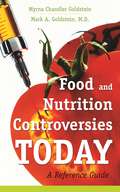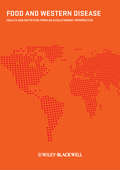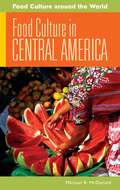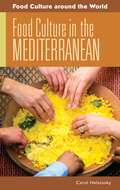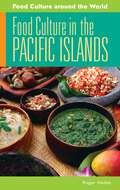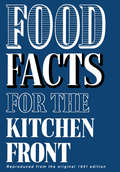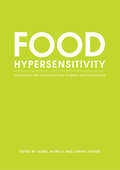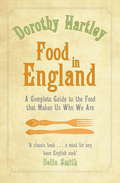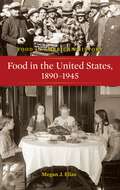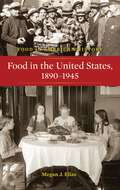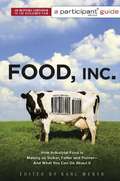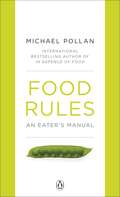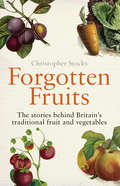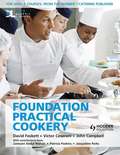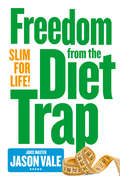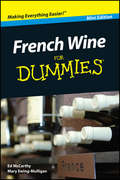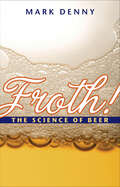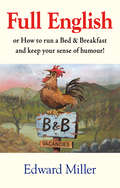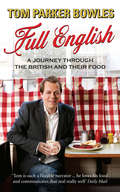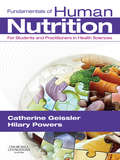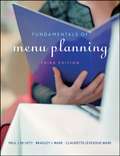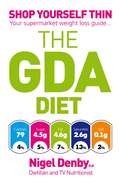- Table View
- List View
Food and Nutrition Controversies Today: A Reference Guide
by Myrna Chandler Goldstein Mark A. MDIs any food safe? Will mad cow disease kill us all? How many calories are really in your restaurant Caesar salad? Modern consumers are besieged with conflicting messages about food and nutrition, making it difficult for the lay person to know what to believe. This no-nonsense resource explores the latest controversies in the field of food and nutrition, presenting readers with the varying opinions and underlying facts that fuel these debates. Fifteen chapters focus on hot topics like organic food, bottled water, and deadly bacterial outbreaks as well as lesser known issues such as food irradiation, vitamin supplementation, animal growth hormones, and more.One of the few resources of its kind, this informative reference is perfect for high school and college students and the conscientious consumer. Since most books on food and diet approach the issues with a clear agenda, this work's unbiased tone and evenhanded treatment of information make it a particularly valuable tool. Features include a detailed index, 20 black and white illustrations, and a rich and deep bibliography of print and electronic materials useful for further research.
Food and Western Disease: Health and Nutrition from an Evolutionary Perspective
by Staffan LindebergNutrition science is a highly fractionated, contentious field with rapidly changing viewpoints on both minor and major issues impacting on public health. With an evolutionary perspective as its basis, this exciting book provides a framework by which the discipline can finally be coherently explored. By looking at what we know of human evolution and disease in relation to the diets that humans enjoy now and prehistorically, the book allows the reader to begin to truly understand the link between diet and disease in the Western world and move towards a greater knowledge of what can be defined as the optimal human diet. Written by a leading expert Covers all major diseases, including cancer, heart disease, obesity, stroke and dementia Details the benefits and risks associated with the Palaeolithic diet Draws conclusions on key topics including sustainable nutrition and the question of healthy eating This important book provides an exciting and useful insight into this fascinating subject area and will be of great interest to nutritionists, dietitians and other members of the health professions. Evolutionary biologists and anthropologists will also find much of interest within the book. All university and research establishments where nutritional sciences, medicine, food science and biological sciences are studied and taught should have copies of this title.
Food Culture in Central America (Food Culture around the World)
by Michael R. McDonaldThis entry in the Food Culture around the World series helps those in the United States understand the new immigrants from Central America who have brought their food cultures with them.Food Culture in Central America illustrates the unique foodways of the region in depth—and in English—for the first time. Important foods and ingredients, techniques, and lore associated with food preparation are surveyed. Typical meals eaten at home are presented, with attention to the cultural context in which those meals take place, including regional or national differences. The book also examines various meal settings—street vendors, modest comedors, and fancy restaurants. The role of food in common festivals and life cycle rituals is explored as well, including Christmas, Semana Santa, and Quincineras.Author Michael R. McDonald emphasizes the living process of "metatezation," referring to the use of the traditional metate, a stone platform used to grind ingredients, resulting in the unique flavors and textures of the cuisines. The process echoes the concept of "mestizaje," the intense hybrid mixture of identities throughout Latin America, which is also explained.
Food Culture in the Mediterranean (Food Culture around the World)
by Carol HelstoskyFood that originated from the Mediterranean area is incredibly popular. Pasta, pizza, gyros, kebab, and falafel can be found just about everywhere. Many people throughout the world have a good idea of what Mediterranean cuisine and diet are all about, but they know less about the entire food culture of the region. This one-stop source provides the broadest possible understanding of food culture throughout the region, giving a variety of examples and evidence from the southern Mediterranean or North Africa (Morocco, Algeria, Tunisia, Libya, and Egypt), the Western Mediterranean or European side of the Mediterranean (Spain, France, Italy, and the French and Italian islands), to the eastern Mediterranean or Levant (Greece, Turkey, Syria, Lebanon, and Israel).The Mediterranean region region is home to three of the world's major religions, and for centuries, the Mediterranean Sea has been an invitation to trade, travel, conquest, and immigration. Where different cultures, beliefs, and traditions mix there is always volatility and tension, but there is also great energy. Understanding the food culture in the Mediterranean is one way readers can see how people of different regions come together, share ideas and information to create new dishes, meals, traditions, and forms of sociability. This volume answers questions such as Do people in the Mediterranean still eat the Mediterranean Diet or do they eat American style? Why is it that the same ingredients can be prepared in so many different ways, even in the same country? Why would cooks take the time to make foods like zucchini, lentils, or figs into dozens of different dishes? How and why do religious rituals differ regarding food preparation? What do Jews, Muslims, and Christians eat on religious holidays? Do people eat out or eat at home? Why is hospitality so important to Mediterranean people and what do they do to demonstrate hospitality and good will through the preparation and serving of meals?
Food Culture in the Pacific Islands (Food Culture around the World)
by Roger HadenThe food culture of the Pacific Islands has been determined by isolation from the rest of the world. Original immigrants from Asia brought their foods, animals, and culinary skills with them, then for several thousand years, they were largely uninfluenced by outsiders. The tropical climate of much of the region, unique island geology and environmental factors also played a role in the evolution of islander cuisine, which is based on unique ingredients. The staples of breadfruit, yams, taro, coconut, sweet potato, and cassava are incorporated into a cuisine that uses cooking and preservation techniques unique to Polynesia, Micronesia, and Melanesia. Today, food culture in the Pacific is largely one of extremes. Although traditional foods and cookery survive and are highly valued, Westernization has meant that the overall diet of islanders has been negatively transformed and that islands are net importers of unhealthful foods. Ironically, the tourism industry has re-engaged islander people in food production and boosted their sense of identity. Students, food mavens, and travellers will find this to be a stellar introduction to the current culture of the Pacific Islands, with discussion of Hawaii, Australia, and New Zealand included. Chapter 1, Historical Overview, offers a fascinating chronicle of the evolution of a food culture of extremes, of isolation, climate, environment, and Western influences. Chapter 2, Major Foods and Ingredients, introduces a host of traditional tropical manna as well as imported products. The Cooking chapter discusses the truly unique cooking styles of the islands, such as steam-baking in the ground in an umu (oven). Chapter 4, Typical Meals, largely explores the emphasis on the ubiquitous processed foods. A Regional Specialties chapter reveals both pan-regional dishes and the noted local dishes. Chapter 6's Eating Out discussion shows the new acceptance of the individualist, recreational ritual of eating away from the community. The typical life-cycle food rituals are covered in the Special Occasions chapter. A final chapter on Diet and Health highlights the increase in Western diseases arising from diet and lifestyle changes and discusses timely food security issues as well. Recipes are interspersed throughout, and a timeline, glossary, selected bibliography, and photos round out the coverage.
Food Facts for the Kitchen Front
by HarperPressThe perfect gift for yourself or someone else, this classy reproduction of a 1940's cooking manual combines time-tested wisdom with practical, no-nonsense recipes.
Food Hypersensitivity: Diagnosing and Managing Food Allergies and Intolerance
by Isabel Skypala Carina VenterSpecialist dietitians, Isabel Skypala and Carina Venter assemble a team of expert authors to separate fact from fiction and provide the reader with an authoritative and practical guide to handling the difficult issue of food hypersensitivity. Offering advice for treating children and adults in one book and written in an accessible style, the book is split into three main sections: Diagnosis Dietary management Allergy prevention and nutritional considerations This exceptional volume is essential reading for all dietitans, nutritionists, paediatricians, allergists, family practitioners, GPs, practice nurses, health visitors and other health care professionals who work in this area or have an interest in food allergy. The book is also an excellent reference for undergraduate and postgraduate students studying allergy, immunology or nutrition and dietetics. Libraries in all universities and research establishments where nutrition, dietetics, food science, medicine and health sciences are studied and taught should have copies of this important work on their shelves
Food In England: A complete guide to the food that makes us who we are
by Dorothy HartleyHer love of the infinite variety of English cooking and her knowledge of British culture and history show why our food should never be considered dull or limited. There are unusual dishes such as the Cornish Onion and Apple Pie, and even recipes for fungi, from common field mushrooms to puffballs. She describes some delicious puddings, cakes and breads, including an exotic violet flower ice cream, an eighteenth century coconut bread and Yorkshire teacakes. The finely-executed line drawings that accompany many of the recipes are more than just beautiful; they inform the cook about different varieties and techniques of food-handling. First published in 1954, FOOD IN ENGLAND was the bible of english cooks and had a deep influence on many contemporary cooks and food writers. It will undoubtedly attract a new generation of admirers.
Food in the United States, 1890-1945 (Food in American History)
by Megan J. EliasNo American history or food collection is complete without this lively insight into the radical changes in daily life from the Gilded Age to World War II, as reflected in foodways.From the Gilded Age to the end of World War II, what, where, when, and how Americans ate all changed radically. Migration to urban areas took people away from their personal connection to food sources. Immigration, primarily from Europe, and political influence of the Caribbean, Latin America, and the Pacific brought us new ingredients, cuisines, and foodways. Technological breakthroughs engendered the widespread availability of refrigeration, as well as faster cooking times. The invention of the automobile augured the introduction of "road food," and the growth of commercial transportation meant that a wider assortment of foods was available year round. Major food crises occurred during the Depression and two world wars. Food in the United States, 1890-1945 documents these changes, taking students and general readers through the period to explain what our foodways say about our society. This intriguing narrative is enlivened with numerous period anecdotes that bring America history alive through food history.
Food in the United States, 1890-1945 (Food in American History)
by Megan J. EliasNo American history or food collection is complete without this lively insight into the radical changes in daily life from the Gilded Age to World War II, as reflected in foodways.From the Gilded Age to the end of World War II, what, where, when, and how Americans ate all changed radically. Migration to urban areas took people away from their personal connection to food sources. Immigration, primarily from Europe, and political influence of the Caribbean, Latin America, and the Pacific brought us new ingredients, cuisines, and foodways. Technological breakthroughs engendered the widespread availability of refrigeration, as well as faster cooking times. The invention of the automobile augured the introduction of "road food," and the growth of commercial transportation meant that a wider assortment of foods was available year round. Major food crises occurred during the Depression and two world wars. Food in the United States, 1890-1945 documents these changes, taking students and general readers through the period to explain what our foodways say about our society. This intriguing narrative is enlivened with numerous period anecdotes that bring America history alive through food history.
Food Inc.: How Industrial Food is Making Us Sicker, Fatter, and Poorer-And What You Can Do About It (A\participant Media Guide Ser.)
by Karl WeberFood, Inc. is guaranteed to shake up our perceptions of what we eat. This powerful documentary deconstructing the corporate food industry in America was hailed by Entertainment Weekly as "more than a terrific movie-it's an important movie.” Aided by expert commentators such as Michael Pollan and Eric Schlosser, the film poses questions such as: Where has my food come from, and who has processed it? What are the giant agribusinesses and what stake do they have in maintaining the status quo of food production and consumption? How can I feed my family healthy foods affordably?Expanding on the film's themes, the book Food, Inc. will answer those questions through a series of challenging essays by leading experts and thinkers. This book will encourage those inspired by the film to learn more about the issues, and act to change the world.
Food Rules: An Eater's Manual
by Michael PollanEat food. Mostly plants. Not too much. Using those seven words as his guide, Michael Pollan offers this indispensable handbook for anyone concerned about health and food. Simple, sensible and easy to use, Food Rules is a set of memorable adages or 'personal policies' for eating wisely, gathered from a wide variety of sources: mothers, grandmothers, nutritionists, anthropologists and ancient cultures among them. Whether at the supermarket, a restaurant or an all-you-can-eat buffet, this handy, pocket-size resource is the perfect manual for anyone who would like to become more mindful of the food we eat. For the past twenty years, Michael Pollan has been writing about the places where the human and natural worlds intersect: food, agriculture, gardens, drugs, and architecture. The Omnivore's Dilemma, about the ethics and ecology of eating, was named one of the ten best books of 2006 by the New York Times and the Washington Post. He is also the author of The Botany of Desire, A Place of My Own and Second Nature and, most recently, In Defence of Food.
Food Technology: Revision Workbook (PDF)
by Judi Sunderland Janet InglisThe student-friendly, uncluttered approach to GCSE revision, guides students through the core content with succinct revision notes and practice questions that focus on the essential content needed for the exams.
Food Technology: Revision Guide (PDF)
by Judi Sunderland Janet InglisWritten for 2009 curriculum change, Essentials provides concise coverage of all the externally assessed course content and skills for GCSE Food Technology.
Forgotten Fruits: The stories behind Britain's traditional fruit and vegetables
by Christopher StocksIn Forgotten Fruits, Christopher Stocks tells the fascinating - often rather bizarre - stories behind Britain's rich heritage of fruit and vegetables. Take Newton Wonder apples, for instance, first discovered around 1870 allegedly growing in the thatch of a Derbyshire pub. Or the humble gooseberry which, among other things, helped Charles Darwin to arrive at his theory of evolution. Not to mention the ubiquitous tomato, introduced to Britain from South America in the sixteenth century but regarded as highly poisonous for hearly 200 years.This is a wonderful piece of social and natural history that will appeal to every gardener and food aficionado.
Foundation Practical Cookery Student Book: Foundation Student Book Level 1 (PDF)
by David Foskett John Campbell Victor CeseraniOver 45 years, Practical Cookery has established itself as a must have for all catering students. Now, for the first time, an edition of Practical Cookery has been written especially for Foundation-level students.
Freedom from the Diet Trap: Freedom From The Food Trap
by Jason ValeA complete physical and psychological guide to the land of the slim and healthy. The Juice Master’s workshops and roadshows contain such antics as the ‘Who Wants to Be a Slimionnaire?’ game. This irreverent but hard-hitting book will ensure people never look at a burger in the same way again!
French Wine For Dummies, Mini Edition (For Dummies Ser.)
by Ed McCarthy Mary Ewing-MulliganNo synopsis available.
Froth!: The Science of Beer
by Mark DennyEver wonder where the bubbles in your beer came from, which way they are going, and why? Have you considered the physical differences among ales, lambics, and lagers? Do you contemplate your pint? Accomplished homebrewer and physicist Mark Denny has crafted a scientifically sound and witty investigation of the physics and chemistry of beer. He recounts and explains the history of and key technological advances in brewing, provides basic instructions for making your own—including a scientific-yet-accessible account of the changes in appearance during each stage of the process—and looks at the fascinating physical phenomena contained within a pint of beer. Along the way he defines the main concepts and terms involved in the process and shows how you can subject the technical aspects of brewing to scientific analysis. If you've ever been curious about how beer is made, why it froths so well, and what makes different types... well... different, then Froth! is for you.
Full English: or how to run a B & B and keep your sense of humour
by Ed MillerEdward Miller has been running a successful B&B enterprise in a peaceful part of the Lake District for over 25 years.Here he tells his story of how it came about and how he learned through trial and error to not only make a decent profit out of it, but to enjoy (nearly) every minute of it.The book is full of incidents, some beyond belief, others rib-tickling or just plain bizarre. But it is also full of practical advice and tips, all of them summarised at the end of each chapter.With cartoons by Robin Grenville Evans.
Full English: A Journey through the British and their Food
by Tom Parker BowlesFrom West Country cider brewers to Yorkshire tripe dressers, Tom meets the punters and producers at the heart of our food traditions. He samples the very best of real English food: Bury black pudding, home-cured Wiltshire bacon and the planet's finest cheddar. But Full English is no paean to an imagined land where yokels sip ale together while chomping on pork pies. Tom's quest delves beneath the surface to unearth the real story behind our eating habits, and what the food of today says about us: organic heaven or mass-produced hell? Peppered with mouth-watering recipes and recommendations, Tom's pilgrimage maps out England's defining dishes: Fish & Chips in the North, Balti in the midlands, Snail Porridge at the Fat Duck. But it is the colourful characters we meet along the way who truly bring Full English to life.
Fundamentals of Human Nutrition E-Book: for Students and Practitioners in the Health Sciences
by Catherine Geissler Hilary PowersFundamentals of Human Nutrition is an authoritative overview that will help you understand the complex subject of human nutrition. This book is a digest of material from the highly successful Human Nutrition 11th edition. ‘Fundamentals’ is intended for a wide readership of students and practitioners who need a broad understanding of human nutrition, but for whom an in-depth knowledge is not essential. Students and practitioners of nursing, pharmacy, sports science, dentistry and other allied health professions, as well as the interested lay person, will benefit from its easy-to-follow, concise approach. Covers all key aspects of human nutrition Up to date with current issues Explains the epidemiology of diet and disease Considers factors affecting food production, trade and access Technical terms explained to help the non-specialist Comprehensive glossary aids understanding Key points summarise all chapters
Fundamentals of Menu Planning
by Bradley J. Ware Paul J. McVety Claudette Lévesque WareFundamentals of Menu Planning, Third Edition presents a complete overview of key aspects of menu planning, including designing, writing, costing, marketing, and merchandising a menu. Reflecting the latest menu trends in the restaurant industry, the authors show how research, surveys, and sales analysis are key to menu planning and design. With updated nutrition and menu planning information, an expanded collection of sample menus, new appendices and resources, numerous forms, tables, and worksheets, and more practice problems, this guide is key to the success of the overall foodservice enterprise.
The GDA Diet: Shop Yourself Thin - Your Supermarket Weight Loss Guide...
by Nigel DenbyThe GDA Diet is the diet for everyone. It is the first and only diet to use the Guideline Daily Amounts (GDAs) food labelling system which has been adopted by leading brands throughout the UK. The GDA Diet is the key to losing weight and keeping it off! It's simple to follow and doesn't involve complicated recipes or fancy foods; in fact it incorporates the everyday products - including ready meals - you'll find in the supermarket. Nothing is banned or off limits, allowing you to eat the foods you love while staying nutritionally balanced and making more informed choices about what you eat. The GDA Diet has been compiled from over 20,000 supermarket products, making it the most comprehensive and varied diet ever! It is full of tips for real people, living busy lives with recommendations for people on budgets, the time pressed and vegetarians, so there are really no more excuses not to eat well and be healthy. Follow the simple guidelines in this diet and you'll confidently be able to break free from the 'yo-yo diet cycle.' This is your passport to a lifetime of permanent weight control and better health.
The GDA Diet: Shop Yourself Thin - Your Supermarket Weight Loss Guide...
by Nigel DenbyThe GDA Diet is the diet for everyone. It is the first and only diet to use the Guideline Daily Amounts (GDAs) food labelling system which has been adopted by leading brands throughout the UK. The GDA Diet is the key to losing weight and keeping it off! It's simple to follow and doesn't involve complicated recipes or fancy foods; in fact it incorporates the everyday products - including ready meals - you'll find in the supermarket. Nothing is banned or off limits, allowing you to eat the foods you love while staying nutritionally balanced and making more informed choices about what you eat. The GDA Diet has been compiled from over 20,000 supermarket products, making it the most comprehensive and varied diet ever! It is full of tips for real people, living busy lives with recommendations for people on budgets, the time pressed and vegetarians, so there are really no more excuses not to eat well and be healthy. Follow the simple guidelines in this diet and you'll confidently be able to break free from the 'yo-yo diet cycle.' This is your passport to a lifetime of permanent weight control and better health.
